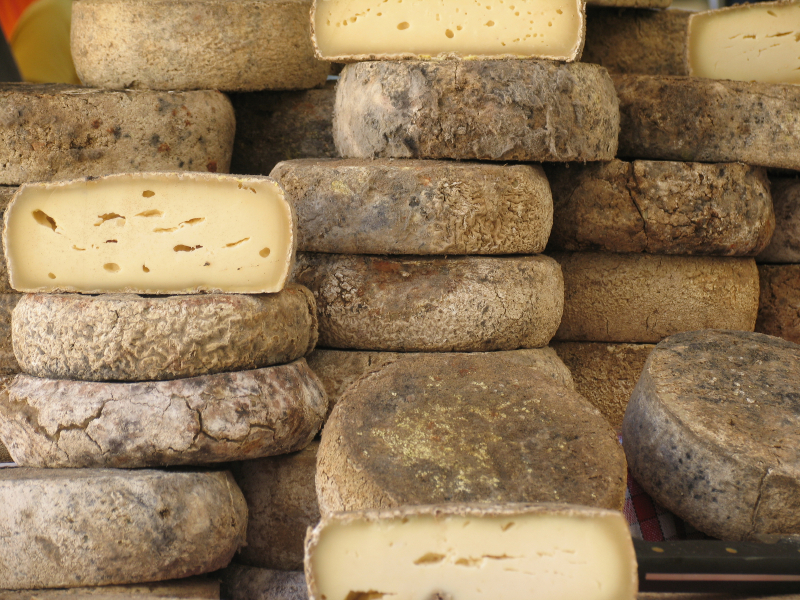
THE FRENCH
FOOD
INDUSTRY'S PORTAL
Webzine
taste it to info

French Cheese Around the World
News /
Tuesday 10 November 2015
USA
French cheese has long been a symbol of haute cuisine in the States. It first started arriving in the US in the mid-20th century, and by the 1970s and 1980s, both cheese platters and fondue pots had become staples of trendy kitchens.
French cheese in the States is usually served as an hors d’oeuvre or appetizer with drinks as opposed to at the end of the meal. Cheese platters often feature several varieties of cheese, accompanied by fruits, honey, chutneys and spreads.
Many French cheeses are not available for sale in the US due to a variety of FDA regulations, such as those on the pasteurization of dairy. One of the first of these regulations was passed in 1985, when the FDA required that all cheese be either pasteurized or aged 60 days before importation, rendering perennial favorites like unpasteurized Brie and Camembert an impossibility. Versions of these French cheeses imported into the States are pasteurized and therefore lack the stong flavor they are known for in France.
More recent regulations include the import block on Mimolette in 2013 due to the natural presence of cheese mites on the rind, or a more recent crackdown on the Food Safety Modernization Act of 2011 with regards to cheese aged on wood, such as Comté, Beaufort and Reblochon.
As a result of these regulations as well recent interest in eating locally, domestic cheese makers have begun producing their own cheeses in the French style. Wisconsin Brie, Vermont French-style goat, and Georgia Camembert are all available on the American market, though pressure from Europe in March of 2014 means that cheeses made in these styles will likely be required to change their names to avoid confusion with AOC designation cheeses.
Asia
Most regions of Asia do not include cheese in their traditional diets. In response, French farmers issued a 2.2 million Euro tender for PR agencies in 2013 in order to reposition French cheese in Japan, China and South Korea as a modern lifestyle choice.
Camembert is by far the most popular French cheese in Japan and can be found in most stores. The Japanese have long viewed France as a pinnacle of western culture, and in 1946, for the Tokyo Olympics, the Japanese flew in planeloads of Camembert, spurring this trend. Today, cheesemakers in Hokkaido have even begun producing their own Camembert, and Japan also makes several camembert-flavored snack crackers. Many other French cheeses, however, can be difficult to find or expensive in Japan.
Market studies show that the Chinese have recently begun acquiring a taste for French cheese as well. While the Chinese are not unaccustomed to strong flavors, like thousand-year eggs, fermented tofu and durian, dairy products are rare in the Chinese diet. Compounded with a high frequency of lactose intolerance amongst the Chinese, there is a general wariness towards French cheese in China. On a visit to Lyon in March 2014, the Chinese president’s wife even refused to sample a slice of Beaufort.
If French cheese still only represents 2.5% of the market shares, Brie and Camembert are quickly becoming contenders, surpassing even milder European cheeses like mozzarella. One issue with the integration of these new flavors is ignorance with regards to serving; some unsuccessfully try to incorporate these new flavors into traditional recipes. Wine makers have already infiltrated the market, so the Chinese market could be cornered with education about wine and cheese pairing.
The South East Asian wariness of dairy is not true of all countries. Local cheeses are made in Nepal and Bhutan from yak milk. North Korean dictator Kim Jong-un, who spent some time in Switzerland, is partial to Emmental. Reports claimed that three North Koreans were being trained in the art of cheesemaking at the Ecole Nationale d’Industrie Latière at Mariolle, though the president of the school denies this.
South Korea, however, upheld a ban on Emmental cheese until 2010, due to a number of factors including the level of propionic acid found in the cheese. After proof from the EU that the acid was naturally occurring, the cheese was allowed into the country. Now that a trend of consuming cheese with alcohol has developed in South Korea, the cheese market is steadily growing.
Middle East
The range of French cheese available in the Middle East has broadened in recent years, due in part to cheese’s rising popularity in the United Arab Emirates. The expatriate population is largely to thank for this change, with a large transformation of the market structure as French cheese importers become more competitive.
Influence is slowly but surely expanding from the UAE into neighboring countries. Imports from French cheese companies like Coeur de Lion and St-Moret are becoming more popular in Egypt thanks to importers, and specialty cheeses like Camembert and Brie are becoming more popular in this region as well.
Europe
Western European countries by and large have their own long-standing cheese cultures. While French cheese is eaten and valued in these countries, the growing popularity of locally focused diets in the 21st century has brought these cheeses, particularly those of Germany and the Netherlands, into the limelight, eclipsing French cheese to a certain extent.
The British Isles are now producing a great number of artisanal cheeses, even exporting many into France such as Cheddar and Stilton. The fact remains, however, that the Brits love French cuisine and cheese. This is largely due to the fact that there are about a third of a million French people living in London alone, but the gourmet connotation of French cheese familiar to Americans is also a factor.
In Eastern Europe, particularly in the former Soviet Union, while local cheese is made, cheeses that are particularly strong or rich hail from France and Germany. In Russia, blue cheeses such as Roquefort and Saint Agur remain popular.





